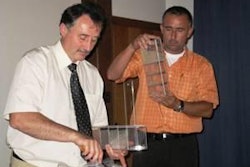
Elections have consequences. The Obama administration’s secretary of labor, Hilda Solis, at her first public speaking engagement as labor secretary in March reportedly said, “The Labor Department is back in business. … Yes, I think you can rest assured that there is a new sheriff in town.” Jordan Barab, acting assistant secretary of labor for OSHA, was quoted as having said, “He wanted to be absolutely clear that OSHA is back in the business of standards and enforcement.” What will this all mean for the poultry industry?
Hiring more inspectors
Edwin Foulke, Jr., partner, Fisher and Phillips LLP, said that the Obama administration’s rhetoric regarding stepped up enforcement has been reinforced by increased funding for OSHA. This funding will be used to increases the number of OSHA inspectors by 25% this year and next, according to Foulke, who addressed the audience at the National Safety Conference for the Poultry Industry in June. He said that expects to see the total number of OSHA inspectors doubled during the four year’s of the Obama administration. Foulke, who was assistant secretary of labor for OSHA, under the George W. Bush administration, pointed out that OSHA conducted more inspections during the Bush administration than it did during the Clinton administration. OSHA statistics also show that work place injury and fatality rates are at lowest rates ever.
Alcmene Haloftis, team leader, office of general industry enforcement, OSHA, said that while it may still be too early to tell where OSHA’s enhanced enforcement effort will be directed, she thinks that some will be directed towards audits of injury and accident data. She said that OSHA is going to look at low injury rate employers in high rate industries, looking for under reporting. It has been alleged that some companies, even some in the poultry industry, have under reported injuries and encouraged employees not to seek medical treatment to keep injury rates artificially low and thus avoid scrutiny from OSHA.
Crossroad to the future
Foulke said that safety and health is at a governmental crossroad. There is a lot of pending legislation which can impact the relationship between employees and employers, particularly the Protecting American Workers Act (PAW) and the Employee Free Choice Act or Card Check. These developments can only make the cost of having an inadequate safety and health program even greater in the future than it has been in the past.
Foulke said that safety will be thrust to the forefront at the corporate level for companies because of its impact on the bottom line. In 2005, direct worker’s compensation costs for most disabling workplace injuries and illnesses were $48.3 billion. Direct and indirect costs to employees for workplaces injuries, illnesses and fatalities were between $160-180 billion per year. Foulke said that no business or facility can achieve its optimal success without a serious commitment to safety and health.
Union organizing activity
Unions want to make safety and health the primary issue in any organizing campaign, according to Foulke. In union organizing campaigns where safety and health was the primary issue in the campaign, the unions won the elections 68% of the time. He said that union organizers can call OSHA with complaints from employees about suspected unsafe working conditions to interest OSHA in conducting an inspection. Any citations found during the inspection can become fodder for the organizing campaign. Foulke said that an effective safety and health program can be a company’s best defense against possible union organizing activities.
A great safety program
“Having a great safety and health program is important, because, morally, it is the right thing to do,” Foulke said. “A great safety program allows your employees to go home each night safely to their family and loved ones.” Having a great safety program can also keep you from having to do the worst job any person would possibly have to do, inform next of kin of a death. Foulke said that he has been involved with over 200 fatality investigations, and that it is something you never want to have to do.
“If your safety and health program is just good, your company will never have great productivity, efficiency and quality,” Foulke said. He said that your safety and health program is even more important today than it was before. Today’s “graying” workforce will get injured more easily, and this will push up workman’s comp costs. The younger generation is, on average, more overweight and less physically fit, and this will raise health care costs. Finally, other countries are catching up to America in productivity, efficiency and quality, so safety and health need to be where we outperform overseas rivals, according to Foulke.
The way for a company to outperform its rivals is to integrate safety with health into all aspects of management and operations, according to Foulke. Companies need to have a sincere commitment to safety and health and address problems head on. He said that in the future employee “wellness” will be critical.


















